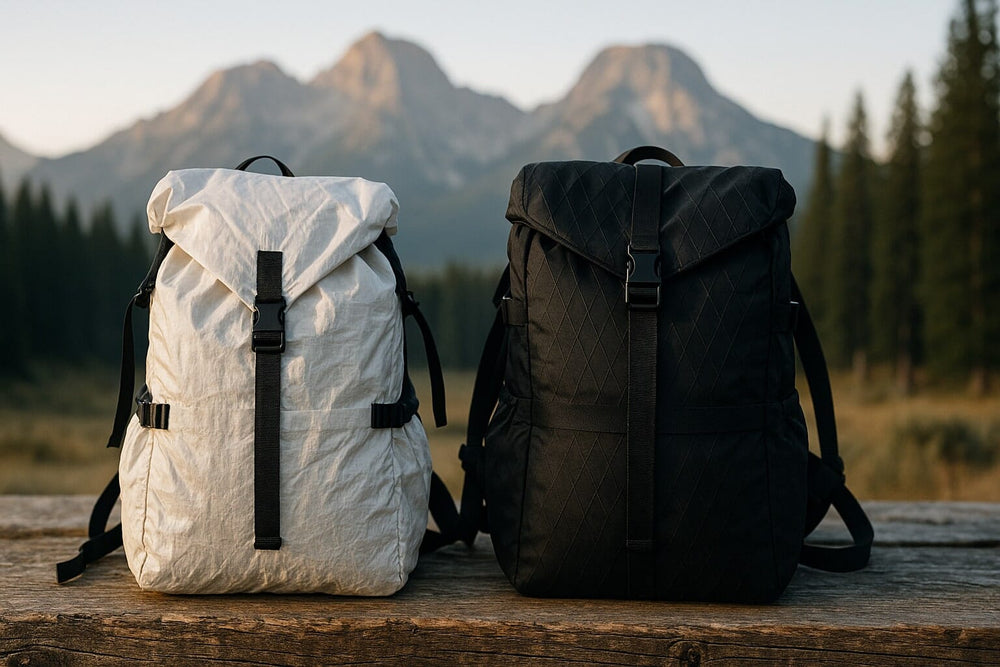
Dyneema vs X-Pac: Which Material is Best for Your Gear?
Reading Time: about
Can't decide between Dyneema and X-Pac for your next tech backpack, EDC pouch, or adventure gear? You're not alone! These two high-tech materials are some of the most sought-after in the outdoor world, bikepacking, and even minimalist urban lifestyles.
One is famous for its insane lightness and unbeatable strength (Dyneema), while the other is known for its rigid structure, waterproofing, and durability that can handle anything (X-Pac). But when it comes to choosing, you’re probably wondering: which one is actually perfect for my needs?
In this article, we're putting these two textile giants head-to-head. No confusing jargon, no hidden ads — just a clear and useful comparison, complete with real-world use cases, a visual breakdown, and our verdict based on what you actually need.
👉 Whether you're an ultralight hiker, a long-distance cyclist, or just a gear geek, hold tight. We've got all the details for you.
1. Why the Struggle Between Dyneema and X-Pac?
On paper, Dyneema and X-Pac seem to be in the same league: high-end, techy materials, ultra-durable, made for adventure. But in reality, they’re as different as night and day in terms of construction, performance, and ideal use.
And that's where things get tricky: Should you go for Dyneema's crazy lightness, or X-Pac's rigid structure and waterproofing? Is a more expensive material always better? Do you really need "bulletproof" fabric for a hike on the GR trails?
👉 Maybe you’re choosing a bag for a trek, a bike tour, or just daily use. And you're probably asking yourself:
- Which one will last longer?
- Which one is more waterproof?
- Does it tear easily?
- Is it really worth the price?
Spoiler alert: there’s no “one-size-fits-all best material.” But there’s a perfect choice for every use. And that’s exactly what we’re about to break down for you.
2. Dyneema: Extreme Lightness, Unreal Strength
Dyneema is like the superhero of textiles. Super thin, almost translucent, yet strong enough to hold back a speeding sailboat. In technical terms, it's a synthetic fiber made from ultra-high molecular weight polyethylene (UHMWPE), known to be up to 15 times stronger than steel at equal weight. Yeah, you read that right.
But beyond the stats, what we love about Dyneema is how it performs in the real world. It’s:
- 🪶 Ultra-lightweight: Perfect for ultralight hikers or bikepacking bags where every gram counts.
- 💪 Incredibly resistant to tension: It practically never gives in under force.
- 💧 Water-resistant: It doesn’t absorb water and can even float on the surface.
- 🧱 Super stable: It keeps its shape, even under prolonged stress.
What We Don’t Always Say About Dyneema
Dyneema isn't a miracle material for every situation. It has its limits, and you should know them before jumping on the bandwagon:
- 🔪 Vulnerable to sharp abrasions: It can easily be cut by sharp objects or repeated rubbing (like a dry branch).
- 🪟 Lacking structure: It’s very flexible, which can make a bag feel “floppy” or hard to pack if it’s not reinforced.
- 💸 Expensive: It’s one of the priciest materials on the textile market.
In Summary: When Should You Choose Dyneema?
✅ You’re after maximum performance, down to the gram?
✅ You're gearing up for a long trek, an off-grid adventure, or ultralight packing?
✅ You love minimalist, high-tech bags?
👉 Dyneema’s your best friend. But be warned: treat it right, because it doesn’t forgive rough handling (or drops on granite).

3. X-Pac: Structure, Waterproofing, Durability
X-Pac is the material that’s won the hearts of technical backpack brands and rugged gear enthusiasts alike. It’s not just a simple fabric, but a multilayer laminate: a sandwich structure combining woven polyester, waterproof PET film, and synthetic fiber X-reinforcement.
The result? An ultra-rigid, waterproof textile that resists deformation. When you hold a bag made from X-Pac, you instantly feel its structure – it’s “square-cut.” This is a material built to last.
X-Pac's Major Strengths
- 💦 Excellent waterproofing: Thanks to its internal film, X-Pac keeps the water out, even during heavy rain.
- 📐 Rigidity and structure: Perfect for quick-access or compartmentalized bags, it holds its shape, even when empty.
- 🔄 Great durability: It stands up well to friction, repeated folding, and daily wear and tear.
- 🔊 “Techwear” look and sound: Its slightly crunchy feel is a hit with fans of minimalist urban aesthetics.
What We Often Forget About X-Pac
X-Pac isn’t perfect for everyone. Here are its little drawbacks:
- ⚖️ A bit heavier than Dyneema: Especially if you're all-in on ultralight packing.
- 🧊 Less flexible: Its rigidity can be a downside if you're looking for a “soft” or compressible bag.
- 🔇 The sound: It makes a slight crunch when handled, which some people don’t love (especially in quiet environments).
In Summary: When Should You Choose X-Pac?
✅ You want a bag with solid structure that keeps its shape no matter what?
✅ You’re biking, in the city, or heading into wet environments?
✅ You love the techwear aesthetic and durable gear?
👉 X-Pac is a fantastic option. It’s a little heavier than Dyneema, but it’s often more versatile for everyday use.

4. Which Material for Which Use?
Now you’ve got a solid grasp of the pros and cons of Dyneema and X-Pac. But which one is the best fit for your activities? No need to guess—we’ve got you covered with real-world use cases.
🥾 Ultralight Trekking & Hiking
🎯 Goal: Lightness, self-sufficiency, long-distance efficiency
✅ Our recommendation: Dyneema
Dyneema reigns supreme here. For multi-day treks where every gram counts, its weight-to-strength ratio is unbeatable.
👉 Examples: Hyperlite Mountain Gear bags, ultralight shelters, DCF backpacks.
🚲 Bikepacking & Bike Touring
🎯 Goal: Vibration resistance, structure, waterproofing
✅ Our recommendation: X-Pac
On the road or gravel, X-Pac shines. It keeps its shape in saddlebags, resists abrasion, and keeps your gear dry.
👉 Examples: Apidura, Ortlieb, or Ateliers Roma bags.
🎒 Urban Use & Minimalist EDC
🎯 Goal: Techwear style, daily durability, structured design
✅ Our recommendation: X-Pac
With its structured look, rigidity, and durability, X-Pac is the go-to material for high-end urban backpacks.
👉 Examples: Mission Workshop, Code of Bell, Black Ember.
🏕️ Challenging Expeditions (Mountaineering, Bushcraft)
🎯 Goal: Reliability, extreme resistance, controlled weight
✅ Our recommendation: Dyneema (reinforced or hybrid)
Dyneema is well-suited for extreme terrains, especially in reinforced versions (like Dyneema Composite Hybrid).
👉 Examples: PHD gear, some CiloGear or KS Ultralight bags.
🌦️ Activities in Very Wet Conditions
🎯 Goal: Long-lasting waterproofing, resistance to the elements
✅ Our recommendation: X-Pac
Thanks to its PET film, X-Pac is naturally waterproof, making it an excellent choice for activities in rainy, maritime, or tropical environments.
👉 Examples: Travel bags or camera bags with waterproof covers.
In Short:
- Optimizing weight? → Dyneema
- Looking for waterproofing? → X-Pac
- Love structured bags? → X-Pac
- Heading to the mountains or on an expedition? → Dyneema
- Want something durable for everyday use? → X-Pac

5. Dyneema vs X-Pac: The Quick Comparison
| Criteria | Dyneema | X-Pac |
|---|---|---|
| 💪 Tensile Strength | ⭐⭐⭐⭐⭐ (up to 15x stronger than steel) | ⭐⭐⭐ (excellent but less than Dyneema) |
| 🪶 Weight | ⭐⭐⭐⭐⭐ (ultra-light) | ⭐⭐⭐ (denser) |
| 💧 Waterproofing | ⭐⭐⭐ (hydrophobic but seams are sensitive) | ⭐⭐⭐⭐⭐ (waterproof PET film) |
| 🔩 Rigidity / Structure | ⭐⭐ (flexible, low structure) | ⭐⭐⭐⭐ (rigid structure) |
| 🔄 Durability in Use | ⭐⭐⭐ (prone to cuts) | ⭐⭐⭐⭐ (long-term durability) |
| 🔧 Ease of Maintenance | ⭐⭐⭐⭐ (hydrophobic, easy to clean) | ⭐⭐⭐⭐ (handles daily use well) |
| 💸 Price | 💸💸💸 (premium) | 💸💸 (more affordable) |
Key Takeaways:
- 🎯 Dyneema excels in lightness and extreme strength, making it perfect for expeditions or ultralight setups.
- 🎯 X-Pac shines with its durability, waterproofing, and structure, making it a great choice for more “everyday” or versatile use.
Conclusion: Dyneema or X-Pac, It All Depends on You
There’s no clear winner between Dyneema and X-Pac, just two different takes on technical fabrics, two ways to approach adventure.
- Dyneema is made for those who obsess over every gram, strive for maximum performance, and want futuristic gear—even if it means paying top dollar and handling it with care.
- X-Pac is perfect for those who want a structured, waterproof, durable bag with no fuss, plus a bold style.
👉 No matter where you stand, the most important thing is choosing a material that fits your real needs. And if you're still unsure, our selection of technical bags will help you make up your mind!
FAQ
What’s the difference between Dyneema and X-Pac?
Dyneema is an ultralight and ultra-strong fiber, perfect for ultralight use. X-Pac is a laminated fabric, more rigid, waterproof, and durable, ideal for structured and versatile bags. One focuses on extreme performance, the other on a balance of strength/comfort/price.
Which one is lighter: Dyneema or X-Pac?
Dyneema is lighter at equal thickness. It’s often chosen for ultralight backpacks or minimalist gear. X-Pac, while a bit heavier, offers better structure in return.
Which one is more waterproof?
X-Pac is naturally more waterproof thanks to its integrated PET film. Dyneema is hydrophobic (it doesn’t absorb water) but often requires sealed seams or a lining for full waterproofing.
Is Dyneema more fragile?
Yes and no. It's extremely resistant to tension but can be more vulnerable to sharp cuts and pointy abrasion. X-Pac is generally more durable against daily wear and prolonged rubbing.
Which material is more durable over time?
X-Pac is often considered more “forgiving” with daily use. Dyneema, if properly maintained, can last a long time but requires a bit more care.
📚 Related Blog Posts
- Ever Heard of Dyneema? Here's Why It's the Superhero of Fabrics!
- What is Cordura? Unraveling the Fabric of Strength
- 30L Backpacks That Excel: Urban, Outdoor, and Travel-Ready Picks
- How to Pack a Backpacking Pack? Expert Guide for Proper Packing
- Waterproof Your Backpack: Easy Methods That Work
- Canvas & Waxed Canvas Fabric - What it is all About?





Leave a comment